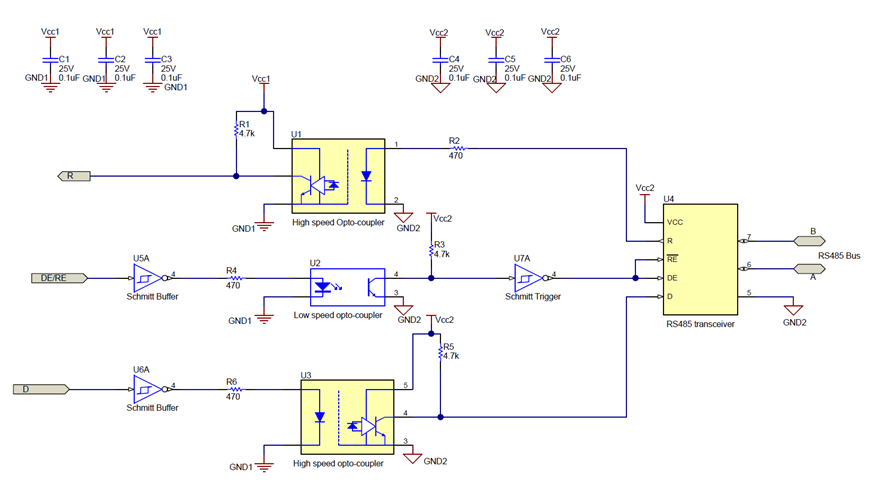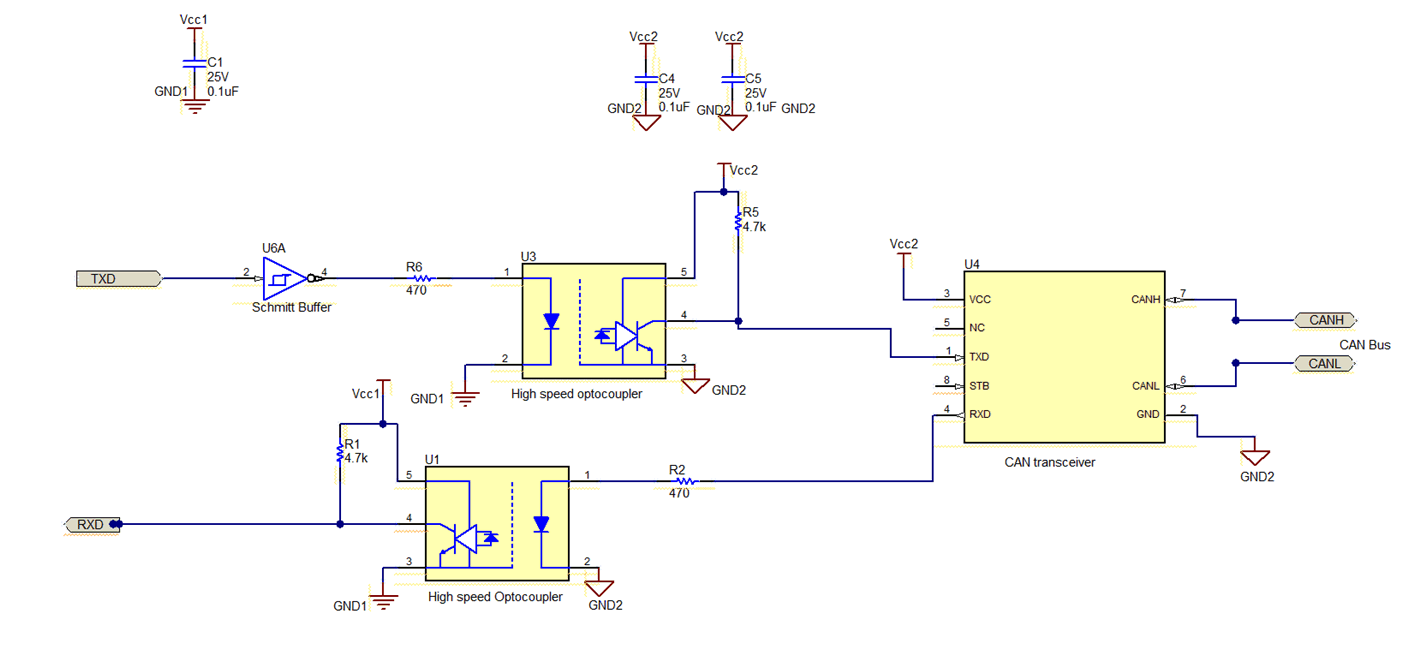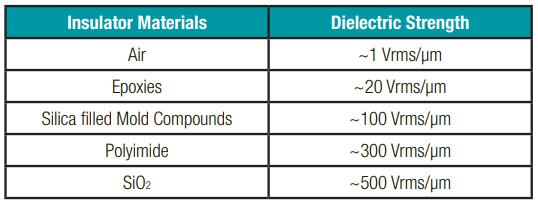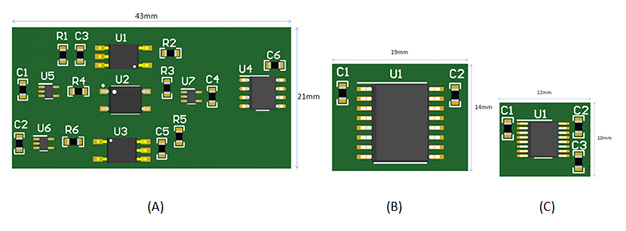SSZT549 january 2019 ISO1044 , ISO1500
Optocouplers, also known as optoisolators or photocouplers, have been used to achieve galvanic isolation in electronic circuits for more than 40 years. Optocouplers use an LED and phototransistor to enable signal communication without the transfer of current. Historically, optocouplers have been popular because they were a low-cost solution. However, given the advancements in digital isolation technology, are optocouplers really the most cost-effective method to isolate common interfaces, such as RS-485 and controller area network (CAN)?
Figure 1 and Figure 2 show typical circuits for isolating an RS-485 and CAN transceiver using optocouplers to achieve galvanic isolation. For an isolated RS-485 solution, three optocouplers are required, two high-speed and one low-speed, along with additional Schmitt buffers for stronger drive to the optocoupler LED and to clean up any noise on low-speed optocoupler transistor output transition, biasing resistors, and bypass capacitors. For the isolated CAN solution, two high-speed optocouplers are required along with a Schmitt buffer, resistors and bypass capacitors. All of these components can add up both in cost and board area.
 Figure 1 An Isolated RS-485 Design
Using Optocouplers
Figure 1 An Isolated RS-485 Design
Using Optocouplers Figure 2 An Isolated CAN Design Using
Optocouplers
Figure 2 An Isolated CAN Design Using
OptocouplersAs industrial systems move toward smaller overall solution sizes and increased functionality with each new product generation, system designers often face board space constraints when adapting designs to meet this trend. For example, motor drives, such as AC and servo drives, which are used to control speed, position, and torque to a motor and are used extensively in industrial automation. These systems need to communicate with a PLC controller, typically through an RS-485 or CAN interface, to execute commands or transfer status of critical drive parameters. The RS-485 and CAN protocols are often used in these systems because of their reliability over long distances. When these nodes are placed at locations with different ground potentials, common-mode noise can cause communication errors, resulting in a need for isolation to prevent this ground-potential difference. Using a bulky optocoupler solution to isolate RS-485 or CAN interfaces can force designers to make compromises elsewhere in the system, driving the need for smaller isolated interface solutions.
| Streamline isolation of CAN ports in industrial systems | |

|
Learn how to replace optocouplers in your isolated CAN designs with our application report, "How to Design an Isolated CAN Port for Space-Constrained Industrial Applications." |
In addition to the large solution size, many designers will also encounter these performance concerns with optocouplers:
- Reliability. Optocouplers
will typically use epoxy as their dielectric; epoxy will break down at lower
voltages compared to other common dielectrics, shown in Figure 2. Assembly inconsistencies and LED degradation will also
cause device-to-device variations in terms of isolation reliability and
lifetime.
 Figure 3 Dielectric Strength of
Common Insulator Materials
Figure 3 Dielectric Strength of
Common Insulator Materials - Power consumption: Each optocoupler requires 5-10 mA to drive the LED on the internal input die.
- Temperature range: Optocouplers are mostly limited to an 85°C maximum ambient temperature, with rare exceptions that are capable of as much as 105°C for a high premium.
- Switching specifications: Rise/fall time and propagation delay in optocouplers can vary depending on the biasing current, current transfer ratio and device-to-device variation.
- Noise immunity: Typical common-mode transient immunity for optocouplers ranges from 15 kV/µs to 25 kV/µs. In the presence of voltage transients above this level, data corruption is likely.
To meet the growing need for compact solutions without compromising performance, TI has created the ISO1500 isolated RS-485 transceiver and the ISO1044 isolated CAN transceiver. Figure 4 compares the solution size of the optocoupler solution shown in Figure 1, an industry-standard 16-pin small-outline integrated circuit (SOIC) isolated RS-485 transceiver and the ISO1500. Note that these designs only show the signal isolation of the RS-485 transceiver. The application note, “How to Isolate Signal and Power for an RS-485 System”, provides a helpful overview for isolating power in RS-485 systems.
 Figure 4 RS-485 Solution Size
Comparison between the Optocoupler Solution (a); an Industry-standard 16-Pin
SOIC Isolated RS-485 Transceiver (b); and TI’s ISO1500 (c)
Figure 4 RS-485 Solution Size
Comparison between the Optocoupler Solution (a); an Industry-standard 16-Pin
SOIC Isolated RS-485 Transceiver (b); and TI’s ISO1500 (c) Figure 5 Isolated CAN Solution Size
Comparison between the Optocoupler Solution (a); an Industry-standard 16-Pin
SOIC Isolated CAN Transceiver (b); and TI’s ISO1044 (c)
Figure 5 Isolated CAN Solution Size
Comparison between the Optocoupler Solution (a); an Industry-standard 16-Pin
SOIC Isolated CAN Transceiver (b); and TI’s ISO1044 (c)For isolated RS-485 designs, the ISO1500 reduces board space by as much as 85% compared to the discrete optocoupler solution and as much as 50% compared to the industry-standard 16-pin SOIC package. For isolated CAN designs, the ISO1044 reduces board space by up to 84% compared to the discrete optocoupler solution and up to 60% compared to the industry-standard 16-pin SOIC package.
In addition to minimizing solution size, the ISO1500 and ISO1044 also solve many of the performance concerns that I mentioned above. All TI isolated RS-485 and CAN transceivers are created in a semiconductor fabrication process using silicon dioxide as the dielectric to minimize device-to-device variation and provide more reliable high-voltage performance. These isolated interface devices can be used from -40°C to 125°C, have predictable switching specifications, and showcase much higher noise immunity compared to a traditional optocoupler. When you combine these system-level benefits with the board-space savings that come with using the ISO1500 and ISO1044, the cost of an optocoupler can add up to be significantly more than the price paid for just the device.
Additional Resources
- View our isolated CAN and RS-485 Portfolios